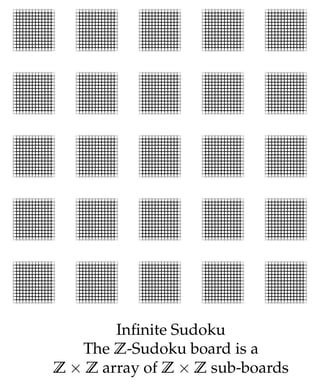Thanks for you kind words about my blog.
In the general size square Sudoku board, you have an $\kappa\times\kappa$ array of $\kappa\times\kappa$ sub-arrays. I think of the local block as a kind of neighborhood, and every location in it having its local coordinates $(\alpha,\beta)$, for $\alpha,\beta<\kappa$. But we have the $\kappa\times\kappa$ array of those local boards, and so the whole local block has its own coordinates $(\gamma,\delta)$. Thus, every location on the Sudoku board is specified by giving the coordinates $(\gamma,\delta)$ of the neighborhood block and the local coordinates $(\alpha,\beta)$ within that block. So four coordinates in all $$(\gamma,\delta,\alpha,\beta)$$ The boundaries between the local boards play no meaningful role.
On the $\mathbb{Z}$-Sudoku board, for example, which I considered on my blog, we have a $\mathbb{Z}\times\mathbb{Z}$ array of $\mathbb{Z}\times\mathbb{Z}$ local boards, and there are no boundaries between these sub-boards.
Assymmetric Sudoku is somewhat more general, since it works with rectangular sub-boards. For any two cardinals $\kappa$ and $\lambda$, one may consider a $\lambda\times\kappa$ array of local boards with shape $\kappa\times\lambda$. Note that the order of the coordinates must swap, in order that the size of the rows and columns is the same (and the same as the size of the sub-boards. Think of a $6\times 6$ board as a $2\times 3$ array of $3\times 2$ matrices. In the general case, every location is specified by the coordinates $(\gamma,\delta)$ of the board, and the local coordinates $(\alpha,\beta)$ within that board, where now $\gamma,\beta<\lambda$ and $\delta,\alpha<\kappa$.
A Sudoku solution is a function $f:(\lambda\times\kappa)\times(\kappa\times\lambda)\to L$, where $L$ is the set of labels (of size $\lambda\times\kappa$) that obeys the three requirements:
- Every row is a bijection with $L$. So $f(\gamma,\delta,\alpha,\beta)$ is a bijection, if you fix $\delta<\kappa$ and $\beta<\lambda$.
- Every column is a bijection with $L$. So $f(\gamma,\delta,\alpha,\beta)$ is a bijection, if you fix $\gamma<\lambda$ and $\alpha<\kappa$.
- Every local board is a bijection with $L$. So $f(\gamma,\delta,\alpha,\beta)$ is a bijection, if you fix $\gamma<\lambda$ and $\delta<\kappa$.
Note that if $G$ is a group of size $\lambda$ and $H$ is a group of size $\kappa$, then we can use these groups as location coordinates, and define $f(g,h,h',g')=(gg',hh')$, taking $L=G\oplus H$ as the set of labels. This is a solution, because if you fix $h$ and $g'$, it is a bijection; and similarly if you fix $g$ and $h'$, or if you fix $g$ and $h$. So every assymmetric Sudoku board has a solution arising in this way. This answers a question asked by Gerhard in a comment on an earlier post.
Actually, this way of thinking leads one to a fourth Sudoku-like condition, namely, requiring that $f(\gamma,\delta,\alpha,\beta)$ is a bijection when you fix $\alpha$ and $\beta$, which is the collection of locations, one per local block, each with the same local coordinates in those blocks. In the group example, this corresponds to fixing $g'$ and $h'$.

